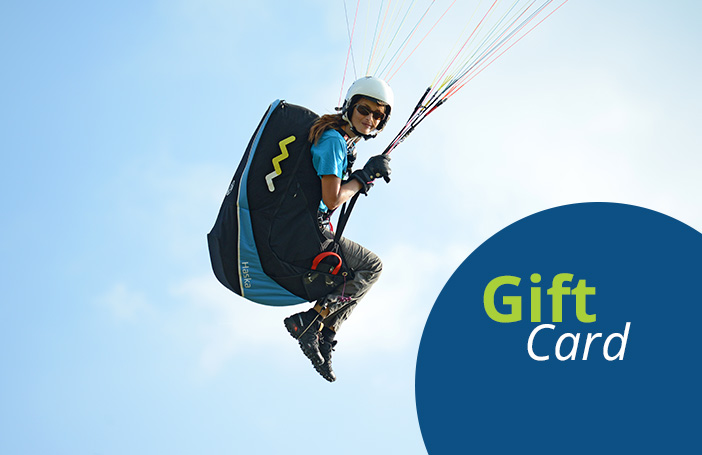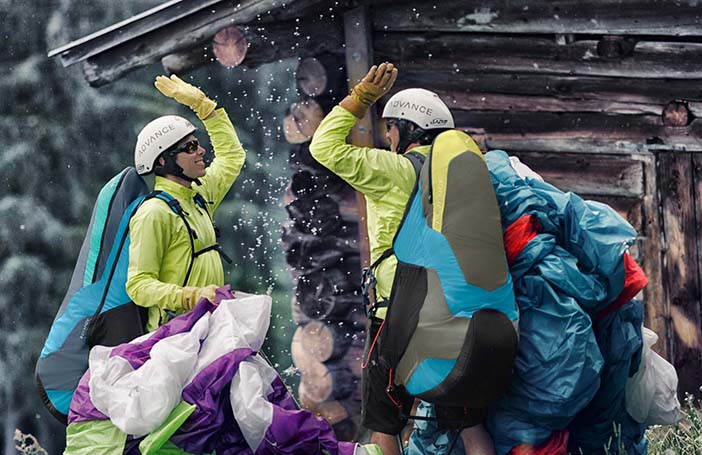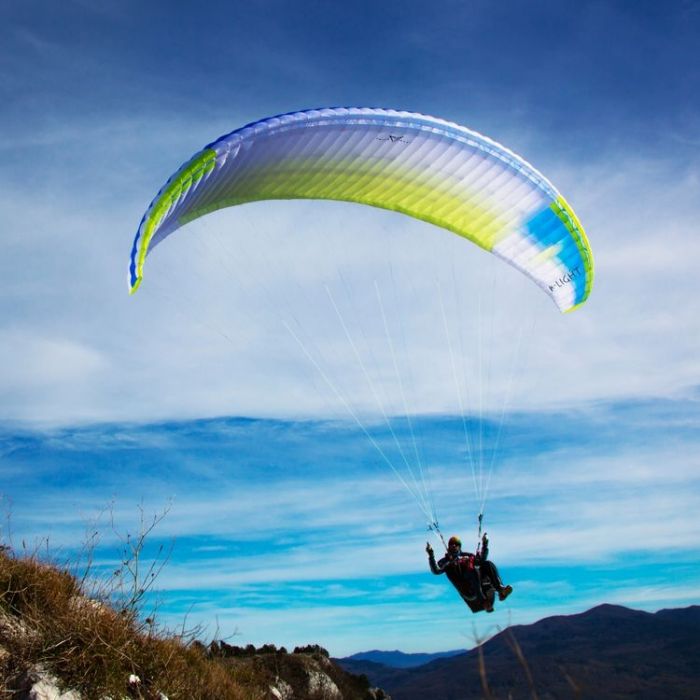
Triple Seven K-light (PAST MODEL)
Select all options to view stock availability

Technical Data
| Size | S | MS | ML | L |
|---|---|---|---|---|
| Number of cells | 51 | 51 | 51 | 51 |
| Projected area (m2) | 20.1 | 22.4 | 23.7 | 25.3 |
| Flat area (m2) | 23.7 | 26.4 | 28.0 | 29.8 |
| Projected span (m) | 8.8 | 9.3 | 9.5 | 9.8 |
| Flat span (m) | 11.4 | 12 | 12.3 | 12.7 |
| Projected Aspect Ratio | 3.8 | 3.8 | 3.8 | 3.8 |
| Flat aspect ratio | 5.4 | 5.4 | 5.4 | 5.4 |
| Glider weight (kg) | 3.5 | 3.9 | 4.3 | 4.6 |
| In-flight weight range (kg) | 65-85 | 75-95 | 85-105 | 100-120 |
| Certification LTF/EN | B | B | B | B |
Colours
- One colour (see images)
K-light: everything you know, but light!
K-light is Triple Seven's answer to a question you may not even know that you asked – but try it and you’ll know!
Designer's thoughts
"We know that most pilots enjoy the increased versatility of the new lightweight generation of wings, and have decided to offer all our new wings in lightweight versions too. The new K-light follows the D-light in this move, and essentially does everything that the Knight does, in a lighter, more compact package. We believe it will be the perfect choice for a wide range of pilots, from hard-core globetrotters to hike&fly enthusiasts, or simply pilots looking for the same experience in a lighter, more compact package – perhaps due to relatively long access walks to their local flying site, or for some other equally reasonable reason."
- Aljaz Valic, Triple Seven designer
Who is this glider for?
The K-light is the perfect Globetrotter paraglider, built to take up minimum space and weight allowance for when you’re packing for that big trip. Once you arrive at your destination it morphs back into the perfect XC machine, more than capable of taking you on BIG flights through unfamiliar skies. Its refined mix of performance and versatility also makes it the first choice for weight-watchers with a less global outlook – take it up any local hill and discover your home sites in a new, more enjoyable way!
Main features
- Back Position Air Intakes – perfect internal pressure at all angles of attack
- Mini-ribs in the trailing edge – better trailing edge definition and reduced ballooning
- An optimized mix of line diameters and materials – performance with maximum longevity and safety
- Refined wingtip design – minimal induced drag and intuitive handling
- Optimized aerofoil – great climbing abilities
- Trim speed adapted to the pilot target group – fast, but not so fast as to be demanding to launch and land…
- Porcher 27g/m2 except for the leading edge
- Porcher 38g/m2 in the high-stress area around the leading edge
- EN B certification
Materials
Area |
Material |
| Leading edge | Porcher Skytex 38 universal |
| Upper surface | Porcher Skytex 27 universal |
| Bottom surface | Porcher Skytex 27 universal |
| Internal construction | Porcher Skytex 27 hard finish |
| Riser webbing | Liros 13mm kevlar |
| Brake ring | Tylaska 4 (original) |
| Pulleys | 4 x Harken P18 |
Triple Seven lightweight risers
A lot of time and dedication went into the riser design; the new risers are not only light but also easier to use and handle that the classic lightweight Dyneema risers; with their flat, traditional look the new ones will feel more familiar to pilots worldwide. Triple Seven was able to reduce the weight by 50% compared to “normal” risers while retaining full strength.
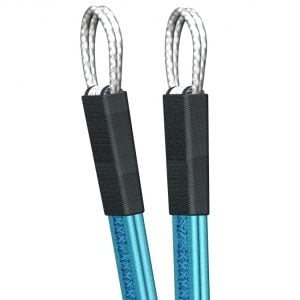
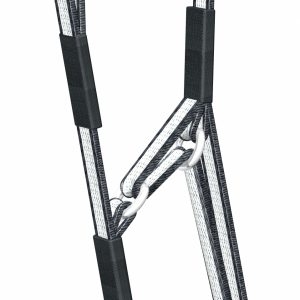
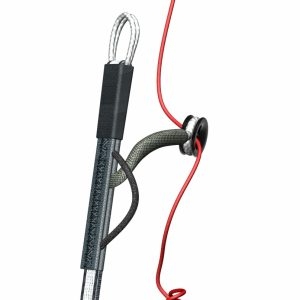
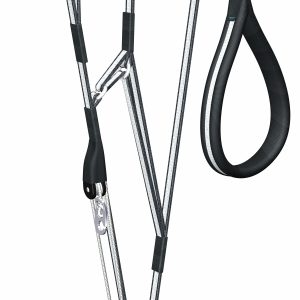
Sliced Diagonal Technology
When paraglider manufacturers first started using diagonal ribs inside the canopies to reduce the number of suspension points and -lines, the default method was to have just one (perforated) diagonal running almost from cell opening all the way back to the C or D suspension point and beyond. At Triple Seven, they were quick to notice that this method was sub-optimal particularly in the leading-edge region of the canopy – as the diagonal curved around the inside of the leading edge, the cloth would get warped and the load distribution exceedingly difficult to control. Triple Sevens solution is to employ several separate diagonal ribs (see illustration), each shaped and cut precisely for the loads it is subjected to in flight. Not only does this extra effort translate into better load distribution and fewer wrinkles, but it also increases canopy integrity in turbulence, to the benefit of real-life glide performance especially at higher speeds.
Back Position (Air) Intake
On conventional paragliders, the location of the cell openings is always a compromise. The cell openings on paragliders must be located at the separation point (the place where the airflow separates into a part that travels OVER the wing, and another part that travels UNDER the wing) and because there is just one separation point, the cell openings must be either very large, or placed either at the separation point for trim speed, top speed or somewhere in between.
At Triple Seven, ALL their wings have been incorporating dual separation point aerofoils since the very first model – they call it the Back Position Intake. On Triple Seven wings the cell opening is located right between the two separation points, allowing Triple Seven to make it smaller while maintaining maximum inflow and thus maximum internal pressure at all angles of attack. With smaller cell openings and greater internal pressure, the collapse tendency at all speeds is significantly reduced, and the brake authority is increased – a big brake input from behind momentarily increases the pressure at the leading edge because the air cannot escape through the small openings, and this makes the leading edge more solid, less collapse-prone for the experienced pilot.
But due to the nature of the BPI even inexperienced pilots benefit from the BPI technology – the stall characteristics are significantly better, and the wing collapses much less in the first place. Triple Seven has also found that BPI aerofoils have better energy retention, making them more efficient in turbulent air – they aren’t as susceptible to being stopped in their tracks by sudden surges, something that makes them convert bumps along the way into altitude much better than conventionally designed paragliders.
Triple Seven was the first manufacturer to employ BPI technology to the full model range, and their extensive experience with this game-changing technology is just one more reason why they believe that a Valic-designed wing will make your flying more rewarding every time you take your wing out of its bag. At the end of the day, this is precisely what paragliding is about – getting the most out of every flying opportunity, regardless of your own personal goals!
Load Distribution Optimization
Drag is also caused by canopy wrinkles; just one more reason to make canopies as wrinkle-free as at all possible.
Enter the Triple Seven Load Distribution Technology
Consisting of a thin Nylon “rod” sewn into each cell wall in a carefully designed wave pattern, the Load Distribution Technology distributes the loads from each line level across the whole chord of the wing, making the wing so much more true to its shape regardless of what the air is doing around it. This translates into a higher resistance to collapses, better energy retention and not least significantly improved gliding performance through turbulent air – and the best part is, with the very thin diameter of the “rods” it doesn’t impede the packing of the wing at all.
Visual Design Optimisation
Although all wings look great from a graphical perspective, there’s more to the design than meets the eye. Each and every seam (except the “7” logo on the wingtips) has been placed precisely where it is for a reason, and there are no more seams in the canopy than necessary for the optimal panel tensioning everywhere. If you design for looks rather than for efficiency you often end up with many more seams than you should ideally have, and every single one will increase the total air permeability of the canopy. In extreme cases this may lead to porosity issues at readings that wouldn’t normally be considered critical – if too much air is escaping via the many seams, then smaller increases in porosity in the individual panels may cause the whole wing to fall over the edge of what is still flyable.
When flying a Triple Seven wing you can rest assured that none of the design elements has been incorporated out of vanity – there are only technical solutions. Fortunately, the discerning pilot will instinctively associate efficiency with attractive!
Smooth Trailing Edge
The paraglider’s trailing edge is a critical part of the design for both glider handling and performance, and one where Triple Seven invest a lot of effort into perfecting it. As the paraglider is inflated, the pressure inside makes the cells billow, and the Triple Seven STE technology is there to control the billowing near the trailing edge. Too much billow in this region shortens the trailing edge in a spanwise direction and may make the canopy pitch unstable in combination with pressure changes. Besides, too much billow at this critical part of the canopy adversely affects performance, because it may cause the airflow to separate in an uncontrolled manner.
With the Triple Seven STE technology, the designers have managed to completely eliminate excessive billowing, making for a much more coherent and sharp trailing edge. This is great news for performance and handling because the solid trailing edge transmits brake line input into turns much more readily.
Optimised Cross Vents
As paraglider canopies grow increasingly complex inside, the number of components in each wing grows as well. If you sometimes wonder why the prices seem to always take a small hike upwards with each new model range, this is the reason for it – a modern canopy is simply far more complex to put together than a five-year-old model was.
But with increasing complexity, one would normally expect the weight to go up as well, and one of the main challenges the Triple Seven designers face when working on new products is to make sure this isn’t the case. A heavier canopy is bad on just about every level, from the basic premise that you still have to carry it on your back, to the fact that heavy canopies launch less readily, and have less enticing handling once in the air. So the challenge is to include all the extra elements inside the wing, but make sure they are as minimal in every way as at all possible. When you look through the (small) cell openings of a Triple Seven wing you’ll notice that all the ribs, and the diagonal ribs, in particular, are very elaborately designed and shaped, the cross ports following the stress lines very accurately, and also that they’re split up into several smaller sections. Through this extra complexity, Triple Seven has managed to get the best of both worlds; the lightness that Triple Seven feel is essential for obtaining the handling and safety characteristics Triple Seven want, and the rigidity and form-wise integrity that gives their wings their hallmark class-bursting performance under real, active flying conditions. It is not a very visible brand characteristic when you see a Triple Seven glider in the air or on the ground, but it is VERY easy to recognise the resulting performance and handling benefits as soon as you take to the air!
Triple Seven K-light reviews
"In conclusion, the K-Light is a great little package. Light, fast and fun. I think there are a few lighter options but the K-Light would be a very good vol-biv wing for those who don’t want to sacrifice XC performance and ease of use." - Cross Country Magazine (full review)
Triple Seven Knight reviews
The Triple Seven K-Light is the light version of the Triple Seven Knight, and very similar. Below are reviews of the Triple Seven Knight.
"Pilot demands seem about right for the Progression class (low B) down on the ground and up in the air. I found the ground handling predictable and easy in all conditions I tested in (varied but not extreme) with a slight tendency to drop back down in lighter conditions. The wing has a reassuring, solid feel in active air, without being too dampened or stiff. The handling can be agile for the class, if you want it to be i.e. if you put in sharper inputs... it certainly has the fun factor! :) Performance seems very good for the class too; I didn't feel disadvantaged compared to other comparable wings. I am happy to recommend the Knight as a low B wing with very good safety, nice handling and good performance. As always, it's important to match the pilot to the right wing - not as easy as it sounds!"
- Carlo Borsattino, Flybubble (full review)
Other Triple Seven Knight reviews
"The Knight is a well thought-out low EN-B with excellent handling, climb rate and overall performance. Perhaps it is one of the best in its class." - Cross Country Magazine (full review)
"Triple Seven has created a ‘master piece’ for the low B category. The impressive cocktail of climb, glide, handling, comfort, ease of use, authority on the brakes, efficiency, is very rare to be found on a low B glider on the market today." - Ziad Bassil (full review)
"... a mid-level Intermediate with good handling and performance, very capable of XC flying." "... the wing is both very stable and has impressive performance." - Thermik magazine (download the full review in German (PDF))
"If we fly relaxed we will find an accessible and docile EN B, but when we ask for action, it surprises with its audacity and an intense sporty character. A fun paraglider, perfect to progress your piloting..." - Ojo volador (full review in Spanish)
Downloads
| Condition | New |
|---|---|
| EN Certification | EN B |
| LTF Certification | LTF B |
| Model Status | Past model |
Standard UK delivery - £3.95 / FREE on orders over £100.
Outside the UK - delivery calculated at checkout (based on the total order value and your delivery address).
We use Royal Mail, Parcelforce Worldwide and other courier companies (e.g. DHL, DPD) depending on shipment value, weight, destination etc.
For more information, please view our order and delivery FAQs page.
If you are not 100% satisfied with your order, you have 14 days from the day of delivery to request a refund.
Delivery costs will not be refunded and you will be responsible for the delivery cost to return the order.
For more information, please read our returns and exchanges policy.


